World's Largest Piedmont Glacier, world record in Alaska
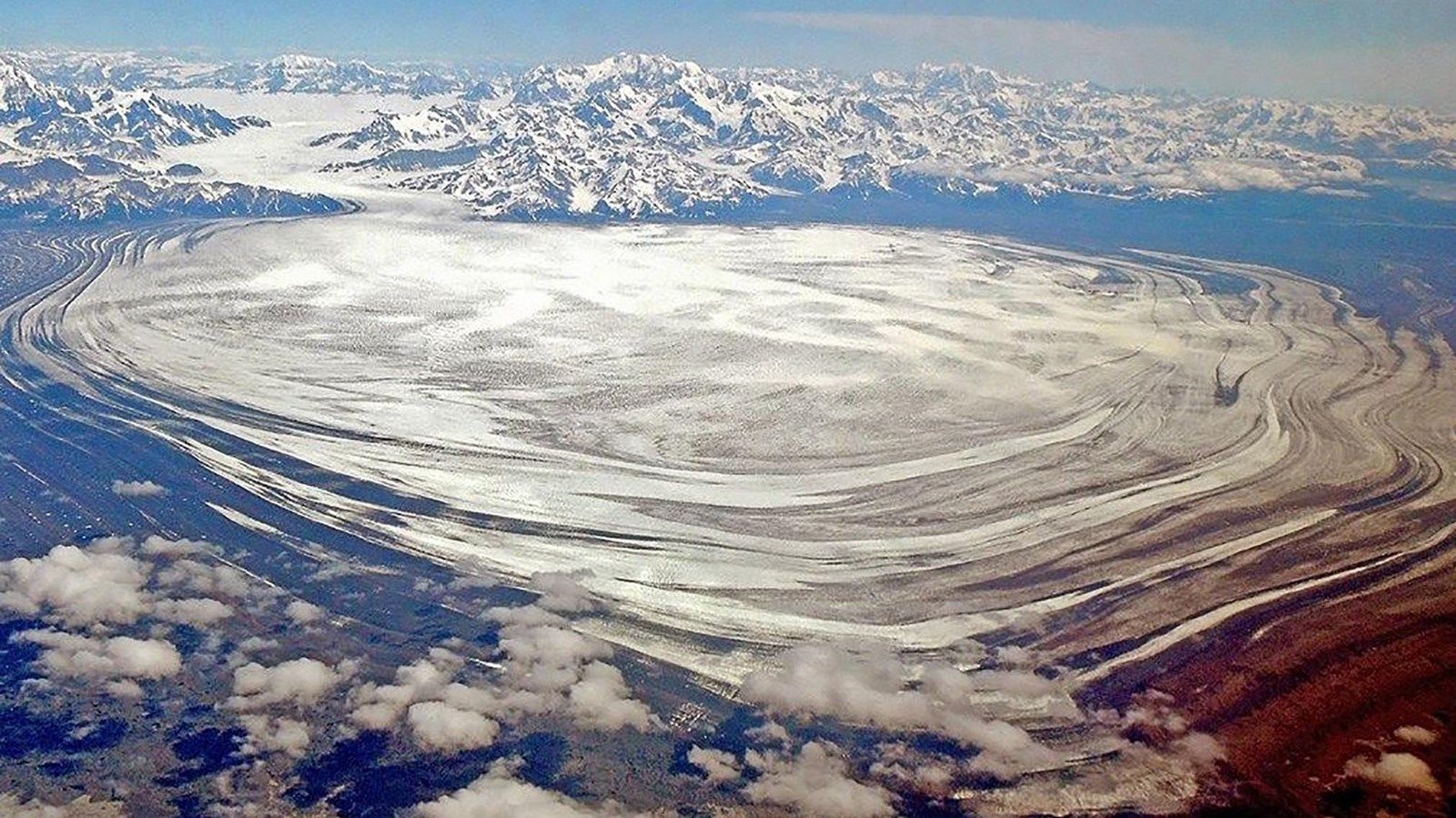
Alaska, United States--Malaspina Glacier, located primarily within Wrangell-St. Elias National Park on the coast, it is about 65 km (40 mi) wide and 45 km (28 mi) long, with an area of some 3,900 km2 (1,500 sq mi), approximately the same size as the state of Rhode Island, thus setting the world record for being the World's Largest Piedmont Glacier, according to the WORLD RECORD ACADEMY.
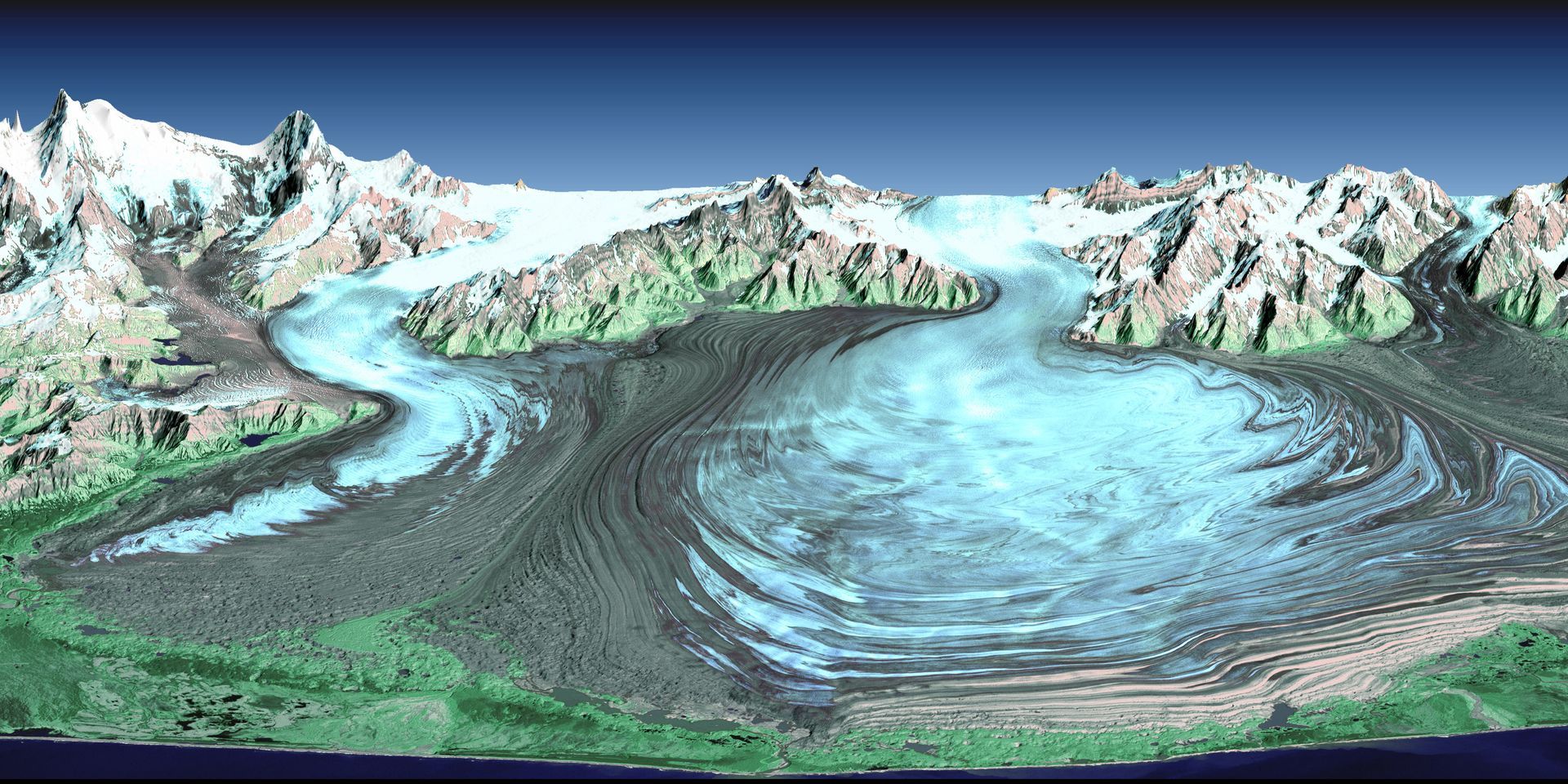
"The massive lobe of Malaspina Glacier in Alaska is clearly visible in this photograph taken from a Space Shuttle flight in 1989. Agassiz Glacier is the smaller glacier to the left," the National Snow and Ice Data Center says.
"The Malaspina Glacier is one of the most famous examples of this type of glacier, and is the largest piedmont glacier in the world.
"Spilling out of the Seward Ice Field (visible near the top of the photograph), it covers over 5,000 square kilometers as it spreads across the coastal plain."
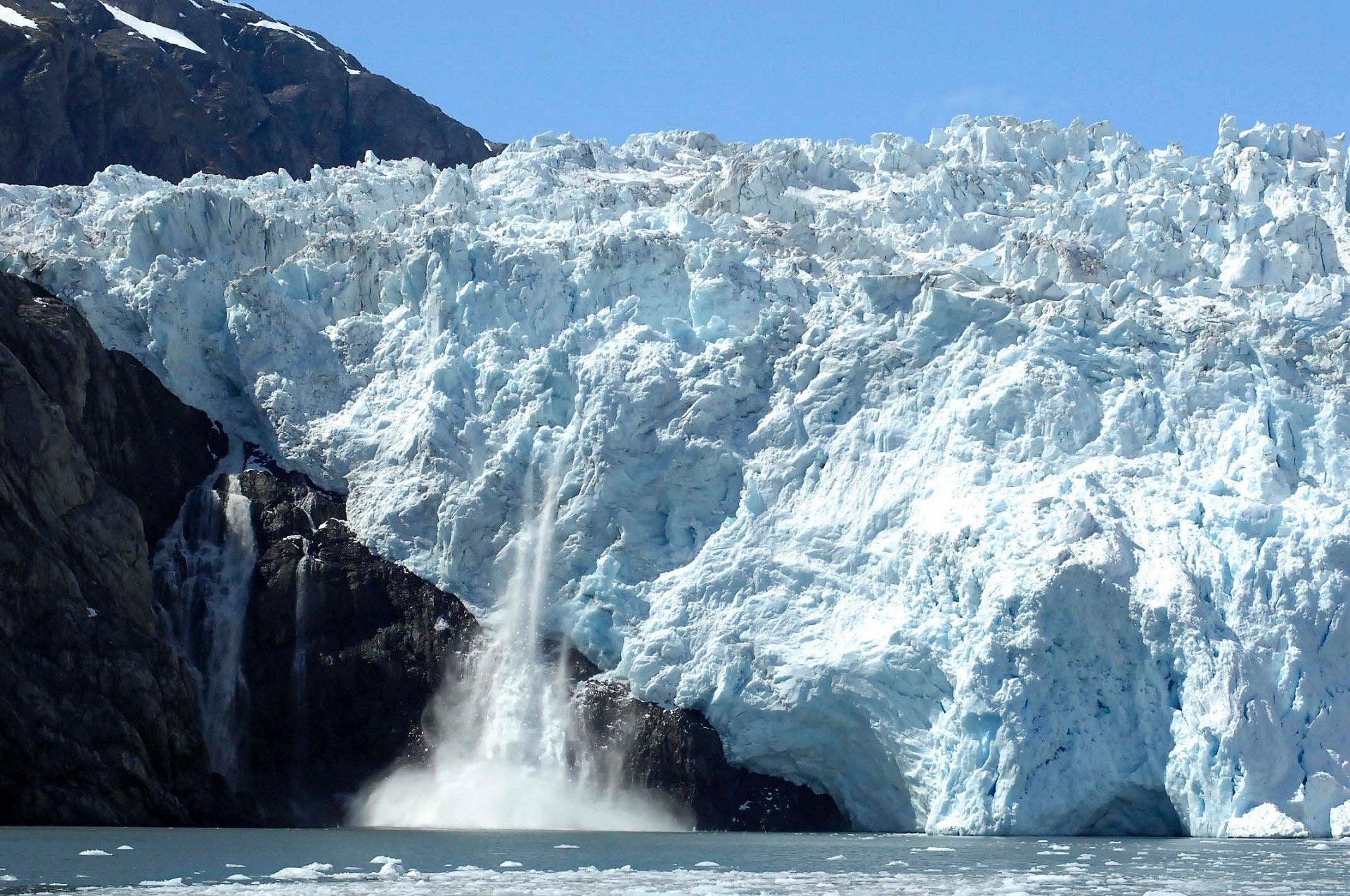
"Malaspina Glacier, located primarily within Wrangell-St. Elias National Park on the coast, is the largest piedmont glacier in North America and one of the largest outside the ice cap regions of the world, at 1,075,409 acres in size," the National Park Service says.
"It provides classic examples of glacial mechanisms and fluctuations. This large body of ice has been noted by explorers concerned with navigation of the western coast of North America for more than two centuries. It was designated as a National Natural Landscape in 1968.
Malaspina is the colonial name for the glacier, in honor of Alessandro Malaspina, a Tuscan explorer in the service of the Spanish Navy, who visited the area in 1791. In 1874, W.H. Dall, of the U.S. National Geodetic Survey, bestowed the name "Malaspina Plateau". Originally, its indigenous name in Tlingit is Sít' Tlein, meaning 'big glacier'."
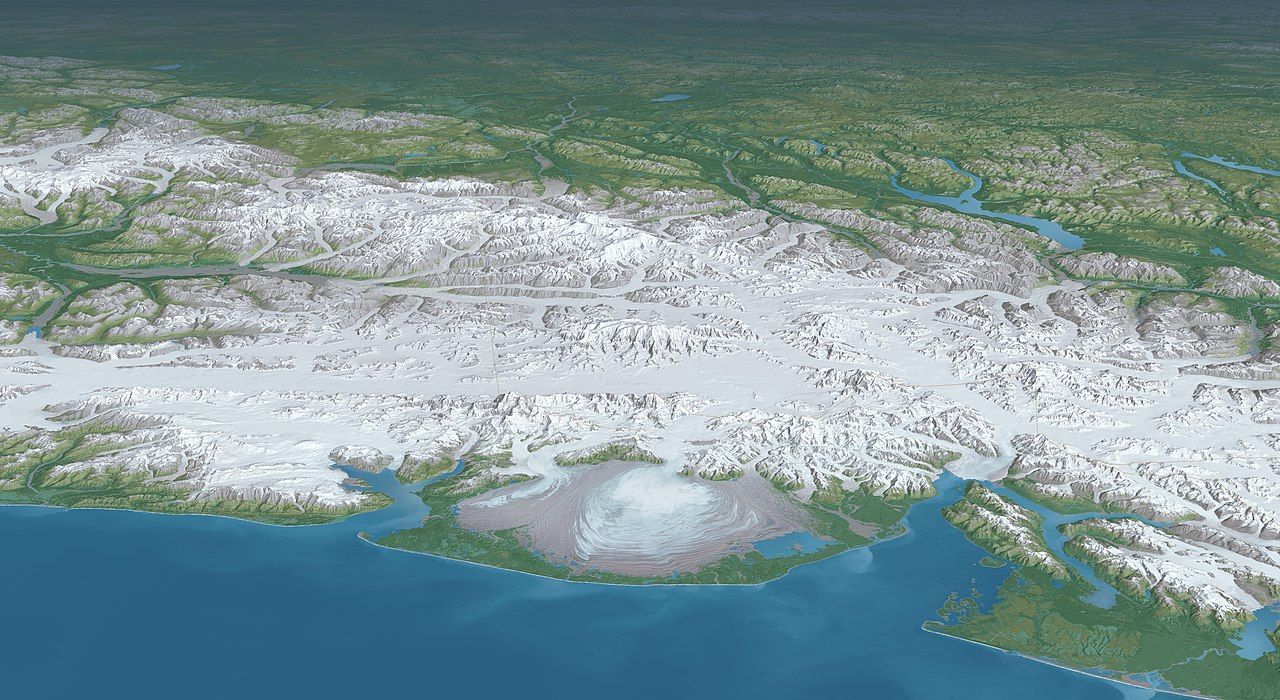
"Alaska is the home of the world’s biggest piedmont glacier – meaning it falls from a mountain into a plain. But a new study has revealed it is not quite as big as previously believed, and its low-elevation positioning makes it more highly susceptible to melting that would affect the rise in global sea levels," the
Alaska Beacon says.
"The findings are in a study of Malaspina Glacier, which spills out of the St. Elias Mountains into a wide circular lobe atop a broad plain that stops short of the sea.
"The study, led by University of Arizona scientists and published in the Journal of Geophysical Research, used specially designed radar devices to conduct what was, in effect, a full-body scan that penetrated down to Malaspina’s base, including into the bedrock underlying it."
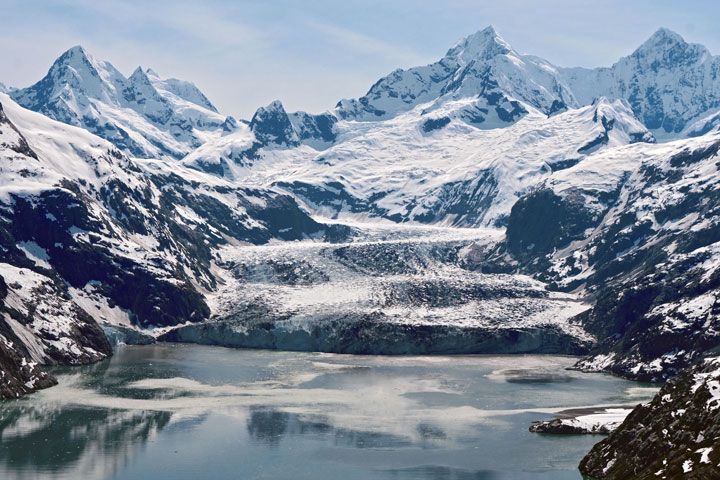
"Understanding the surges and retreats of Alaska's Malaspina Glacier is key if climate change models are to be applied to the glacier with confidence. Work by graduate student Victor Devaux-Chupin at the University of Alaska Fairbanks Geophysical Institute is providing some answers," the Phys.org says.
"The Malaspina consists of three lobes, each fed by its own glacier. The Agassiz glacier becomes the Malaspina's western lobe, the Seward glacier forms the center lobe, and the Marvine glacier is the eastern lobe. Devaux-Chupin's analysis of data from 1984 to this year shows the Malaspina surges approximately every 10 years, principally from the central lobe, which is the largest.
"Study of the glacier is important for climate change analysis because the Malaspina is the world's largest piedmont glacier, a type of glacier in which the flow spills from a narrow valley into a flat plain and spreads out like a fan. Malaspina Glacier covers about 1,500 square miles and is easily accessible to researchers. Many other piedmont glaciers are in Antarctica and Greenland and not readily accessible."
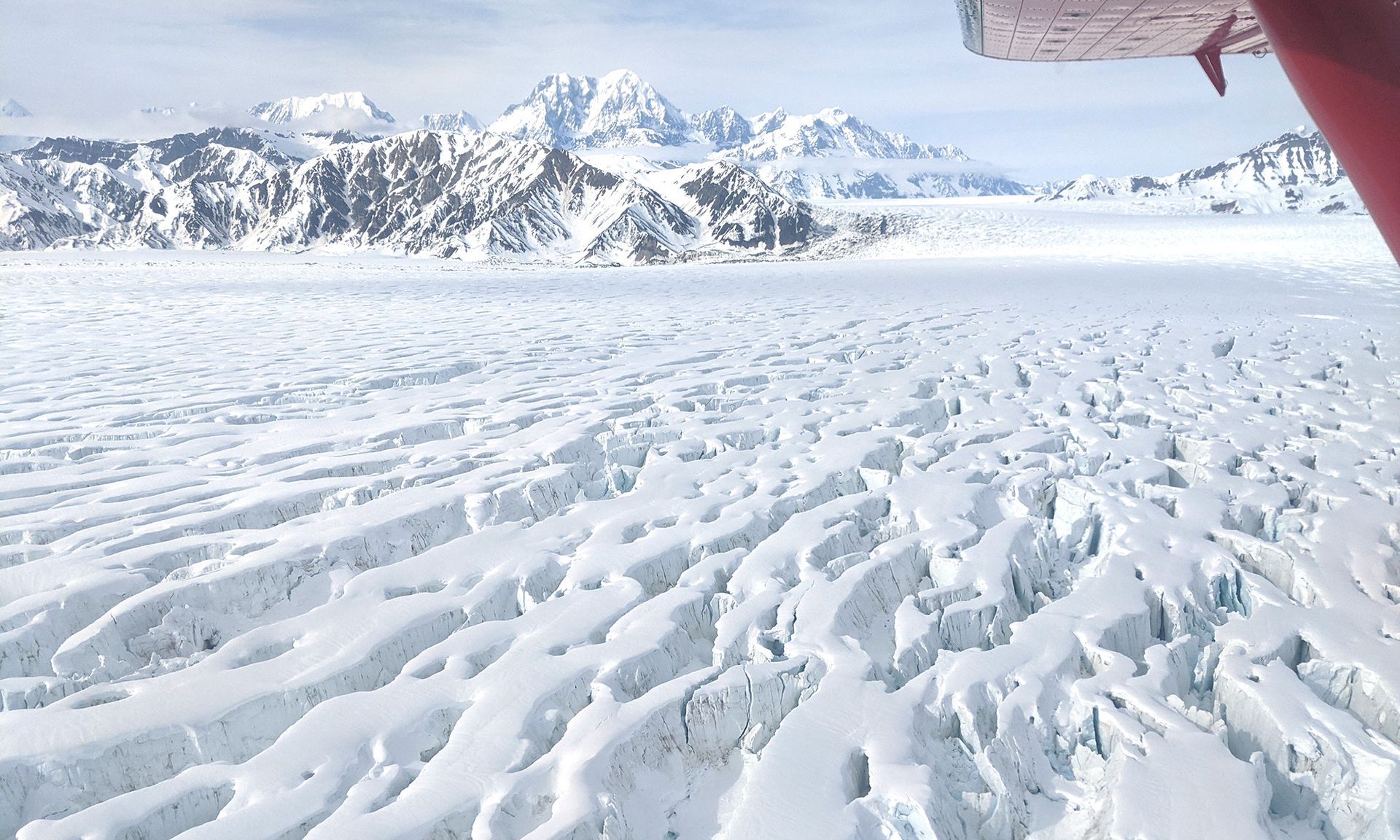
"The Malaspina Glacier in southeastern Alaska is the largest piedmont glacier in the world. Situated at the head of the Alaska Panhandle, it is about 65 km (40 mi) wide and 45 km (28 mi) long, with an area of some 3,900 km2 (1,500 sq mi), approximately the same size as the state of Rhode Island.
"The Malaspina Glacier actually comprises Seward Glacier, Agassiz Glacier, and Marvine/Hayden Glacier, which converge as they spill out from the Saint Elias Mountains onto the coastal plain facing the Gulf of Alaska between Icy Bay and Yakutat Bay. Officially, these three glaciers are classified independently, such that Malaspina Glacier does not technically exist.[3] The three glaciers are almost always referred to together, though sometimes only the largest primary piedmont lobe is referred to as Malaspina Glacier.
"The Malaspina is up to 600 meters (2,000 ft) thick in places, with the elevation of its bottom being estimated to be as much as 300 m (980 ft) below sea level. There are two lakes on its margins: Oily Lake to the northwest, at the foot of the Samovar Hills between the Agassiz and Seward glaciers, and Malaspina Lake to the southeast, close to Yakutat Bay." (Wikipedia)

"Malaspina Glacier, located on the coast of southern Alaska, is the world's largest piedmont glacier. A narrow ice-cored foreland zone undergoing rapid thermokarst erosion separates the glacier from the relatively warm waters of the Gulf of Alaska. Glacier-wide thinning rates for Malaspina are greater than 1 m/yr, and previous geophysical investigations indicated that bed elevation exceeds 300 m below sea level in some places," the AGU Publications says.
"These observations together give rise to the question of glacial stability. To address this question, glacier evolution models are dependent upon detailed observations of Malaspina's subglacial topography. Here, we map 2,000 line-km of the glacier's bed using airborne radar sounding data collected by NASA's Operation IceBridge. When compared to gridded radar measurements, we find that glaciological models overestimate Malaspina's volume by more than 30%. While we report a mean bed elevation 100 m greater than previous models, we find that Malaspina inhabits a broad basin largely grounded below sea level.
"Several subglacial channels dissect the glacier's bed: the most prominent of these channels extends at least 35 km up-glacier from the terminus toward the throat of Seward Glacier. Provided continued foreland erosion, an ice-ocean connection may promote rapid retreat along these overdeepened subglacial channels, with a global sea-level rise potential of 1.4 mm."
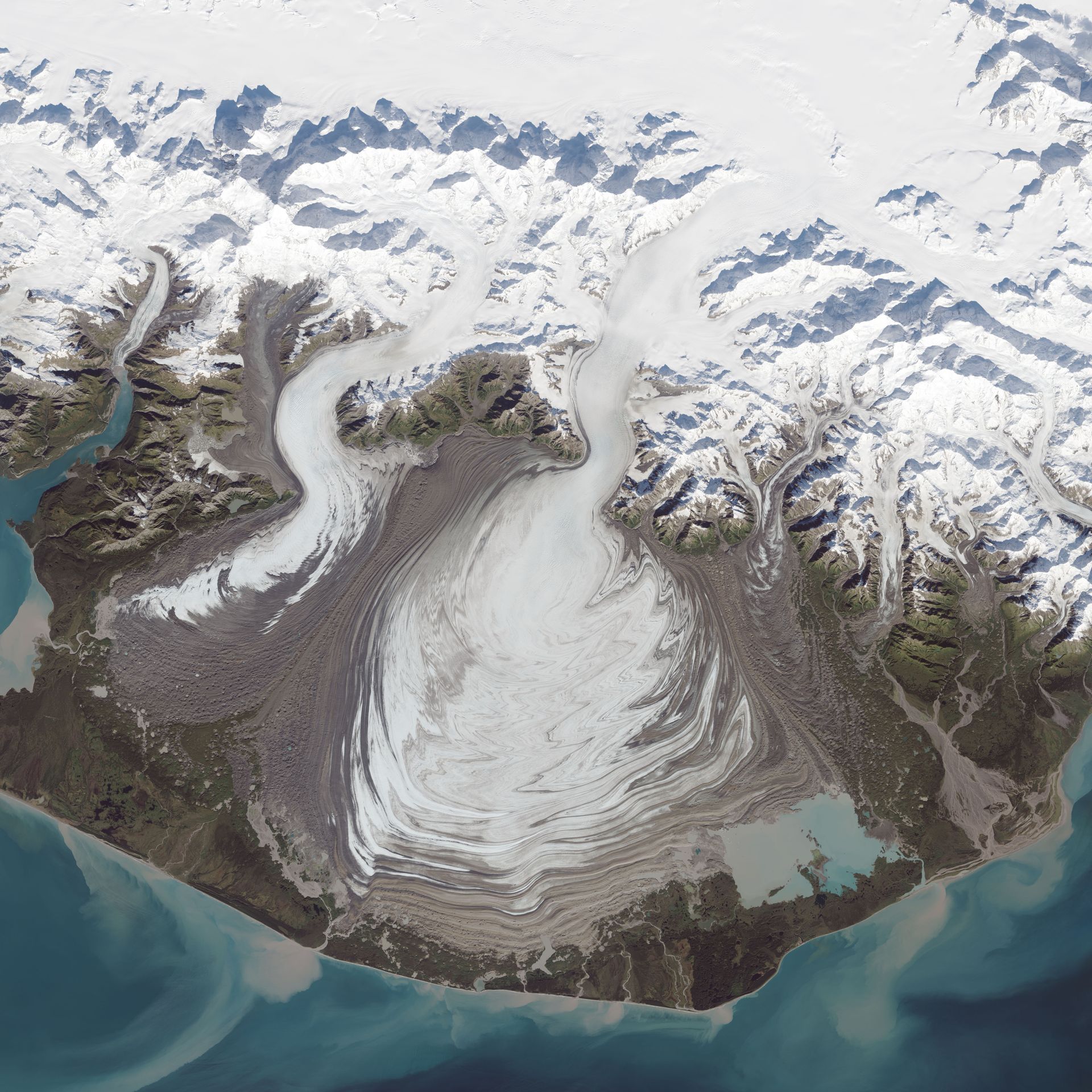
"The ice of a piedmont glacier spills from a steep valley onto a relatively flat plain, where it spreads out unconstrained like pancake batter. Elephant Foot Glacier in northeastern Greenland is an excellent example; it is particularly noted for its symmetry. But the largest piedmont glacier in North America (and possibly the world) is Malaspina in southeastern Alaska," the NASA Earth Observatory says.
"The main source of ice comes from Seward Glacier, located at the top-center of this image. The Agassiz and Libbey glaciers are visible on the left side, and the Hayden and Marvine glaciers are on the right.
"The brown lines on the ice are moraines—areas where soil, rock, and other debris have been scraped up by the glacier and deposited at its sides. Where two glaciers flow together, the moraines merge to form a medial moraine. Glaciers that flow at a steady speed tend to have moraines that are relatively straight."
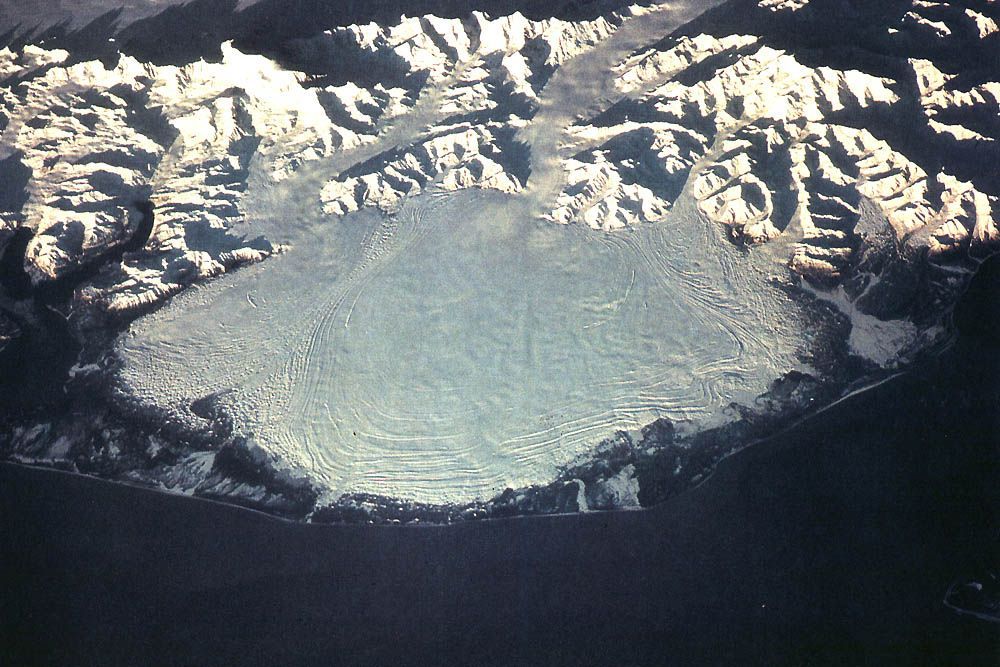
"The largest piedmont glacier in North America, and outside the polar regions, is in found in southeastern Alaska and is known as the Malaspina Glacier. Malaspina Glacier is also Alaska’s largest glacier and lies west of Yakutat Bay," the
Geography Realm says.
The glacier is named after Alessandro Malaspina, an Italian explorer with the Spanish Navy who visited the area in 1791. Malaspina Glacier was designated as a National Natural Landscape in 1968. This piedmont glacier is 65 km (40 mi) wide and 45 km (28 mi) long, with an area of some 3,900 km2 (1,500 sq mi).
"Malaspina Glacier is a compound glacier, formed by the merger of several valley glaciers. The Malaspina is divided into three lobes. The western lobe of the Malaspina is formed by the Agassiz glacier, the center lobe by the Seward glacier, and the eastern lobe by the Marvine glacier."
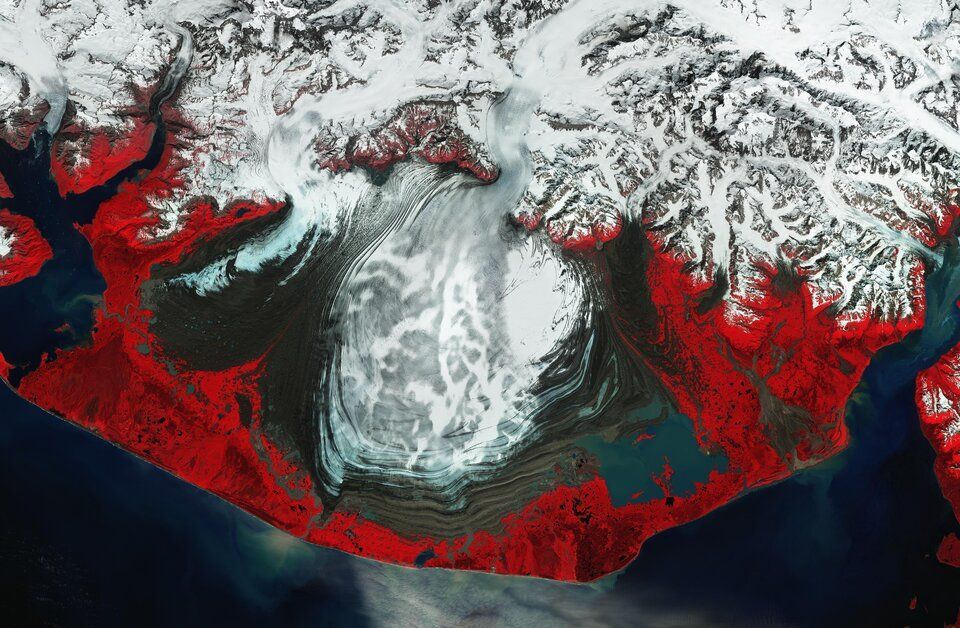
"Malaspina Glacier is located west of Yakutat Bay in southeast Alaska, US. Covering an area of around 2900 sq km, the glacier flows for around 80 km along the southern base of Mount St. Elias and is around 300 m thick," the
European Space Agency says.
"Malaspina flows faster than the piedmont glaciers in Antarctica and Greenland. Piedmont glaciers flow from a steeply sided valley, where the ice is constrained by mountains, onto a flat plain. The change in environment from narrow to wide creates the piedmont’s signature rounded lobe.
"This Sentinel-2 image shows the central lobe of the glacier surging towards the sea. This image has been processed using the near-infrared channel to highlight vegetation in bright red. The wavy lines around the lower half of the glacier are rock, soil and other debris that have been deposited by the glacier – called moraines."
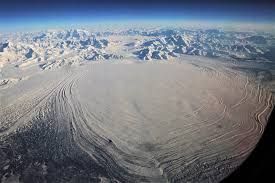
"Understanding the surges and retreats of Alaska’s Malaspina Glacier is key if climate change models are to be applied to the glacier with confidence. Work by graduate student Victor Devaux-Chupin at the University of Alaska Fairbanks Geophysical Institute is providing some answers," the
University of Alaska Fairbanks says.
"The Malaspina consists of three lobes, each fed by its own glacier. Devaux-Chupin’s analysis of data from 1984 to this year shows the Malaspina surges approximately every 10 years, principally from the central lobe, which is the largest. The glacier is surging once again, and the central lobe is leading the way.
"Study of the glacier is important for climate change analysis because the Malaspina is the world’s largest piedmont glacier, a type of glacier that spills from a narrow valley into a flat plain and spreads out like a fan. Because much of the Malaspina Glacier is below sea level, an advancing lake of seawater could form in the depression left when the glacier eventually retreats. Ocean contact hastens glacial retreat."
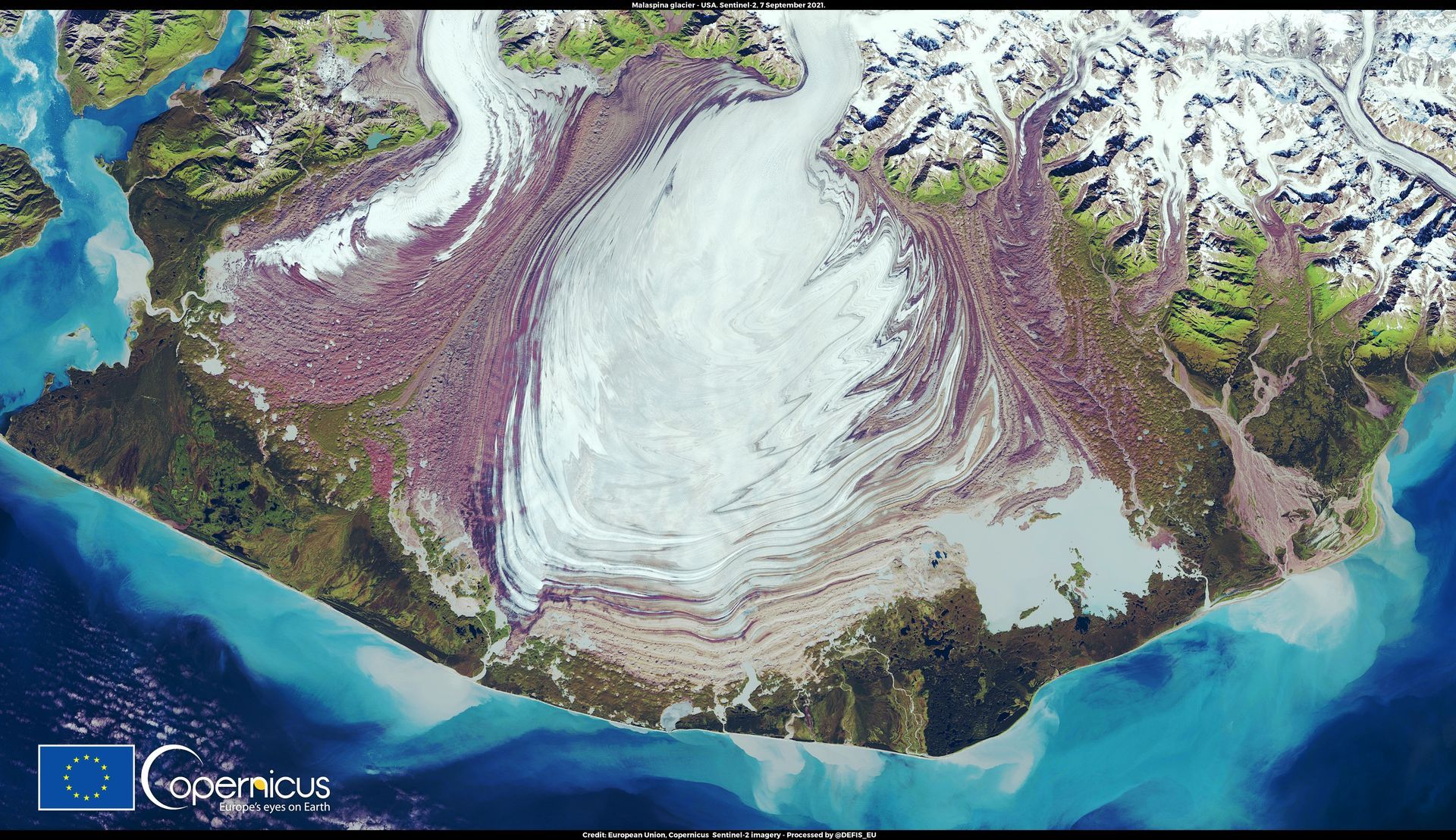
"This image, acquired by one of the Copernicus Sentinel-2 satellites on 7 September 2021, shows the Malaspina Glacier in Alaska, USA," the
Copernicus says.
"Malaspina is the largest piedmont glacier in the world. It flows faster than the piedmont glaciers of Antarctica and Greenland and is therefore widely studied by scientists around the world. In particular, its cycles of surges and retreats and its vulnerability to climate change have recently been studied using Copernicus and Landsat data.
"Among the most interesting results, it was found that in the event of a sea level rise induced by global warming, seawater could cause major changes in the glacier's terminus and lead to severe impacts on habitats in the area."
Photos: World's Largest Piedmont Glacier, world record in Alaska
(3) Phys.org
(6) University of Arizona News
(7) Phys.org
(9) NASA/Wikipedia
(11) Spot on Alaska
(12) Copernicus
Related world records:
World Largest Snowflake, world record at Fort Keogh, Montana
Largest known sub-aerial landslide on Earth, world record in Wyoming
World's Largest Bentonite Deposits, world record in Wyoming
World’s Largest Trona Deposit, world record in the Green River Basin, Wyoming
World’s Largest Rhythmic Spring, world record near Afton, Wyoming
World's Largest Mineral Hot Springs, world record in Thermopolis, Wyoming
World's First National Park, world record in Wyoming
World's First National Park, world record in Wyoming
World's Highest Hill: world record near Poteau, Oklahoma
World’s largest artificial reef: world record off Grand Isle, Louisiana
World's Longest Cave System: world record in Edmonson County, Kentucky
World’s Largest Cannonball Concretions: world record in Rock City, Kansas
World’s Heaviest Hailstone On Display: world record in Coffeyville, Kansas



